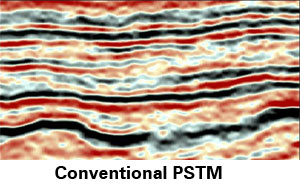BE® Imaging
Bandwidth Extension (BE®) has historically been run post-migration and it works very well, but is dependent on the imaging with conventional frequencies.
Running BE® before migration provides an increase in spatial resolution. The improvements come from three sources. First, the increase in the bandwidth pre-migration will reduce both vertical and lateral wavelets post-migration and increase both vertical and lateral resolution. Second, the sharpness of the gathers before migration allow for a much more accurate initial velocity model. This in turn allows for a more accurate stacking velocity model, which translates into a more accurate interval velocity model. Third, after migration, since the common image gathers are higher resolution, this will allow for a more accurate picking of depth errors and horizons to go into our tomographic updating software.
Needless to say, high resolution seismic coupled with high resolution velocity demands a high resolution set of migration parameters, so things like bin spacing, offset spacing, depth sample and spatial velocity sampling for updating need to be revisited after BE®. The resulting image will provide a better representation of the subsurface structure and stratigraphy.
Flow:
- BE® run on final un-migrated gathers
- Hi-res migration velocity model building
- PSTM or PSDM with High Resolution data and velocities as input
- Gather Conditioning
- Stack
Benefits:
- Improved spatial (lateral and vertical) resolution
- Sharper, crisper faults
- Better imaging of thin stratigraphic reservoirs
- Best possible input to pre- or post-stack inversion, OVT, Pore Pressure Prediction
BE® Imaging Input Data Requirements
Minimum Processing:
- Geometry Application and Corrections
- Spherical Divergence
- Shot Domain Noise Attenuation (if necessary)
- Deconvolution
- Refraction Statics and Residual Statics
- No NMO correction applied
- Data should be at the same datum as the velocities
- Any final datum correction should be in the headers for application at a later time
Required Header Information:
- Source Line and Source Station
- Source X and Y
- Receiver Line and Receiver Station
- Receiver X and Y
- CMP-X and CMP-Y
- Inline and Crossline
- Unique Ensemble Identifier (Field File Number or CDP Number)
- Final Datum Correction Value




